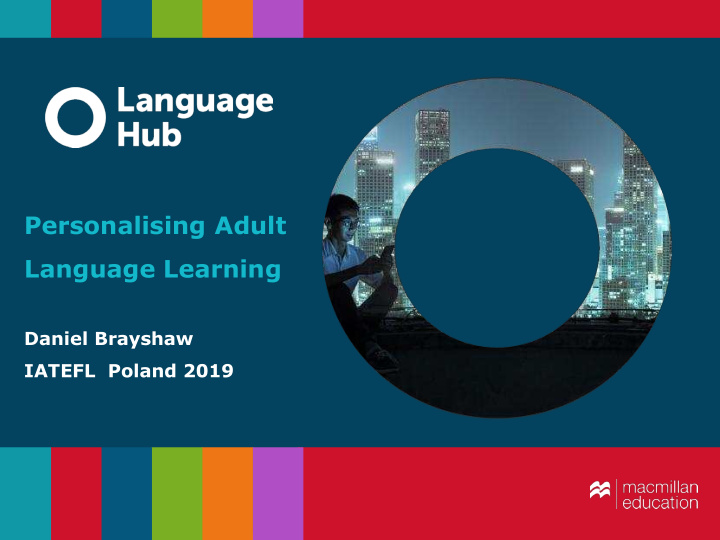



Personalising Adult Language Learning Daniel Brayshaw IATEFL Poland 2019
Tea or coffee? tea or coffee spicy or mild wild night out or quiet night in Pitt or Clooney
Basic principles Personalised language output o Motivation o Set-up o Task preparation o Closure
Today’s session... Personalising Adult Language Learning Definition & origins o Humanistic methodology Personalising input o Making practice meaningful Personalising output o Pitfalls and solutions Providing feedback o Delayed error correction Slides
Language Hub 6-level Adult GE course o Takes the complexity out of teaching o Personalisation o
Definition & origins o of personalisation
Over to you... o Write a 1 sentence definition of personalisation in the context of ELT.
Defining Personalisation o “When you personalise language you use it to talk about your knowledge, experience and feelings” (Thornbury An A-Z of ELT ). o “Personalisation happens when activities allow students to use language to express their own ideas, feelings, preferences and opinions” (BC Website Teaching English ). o ”When students use language to talk about themselves and things which interest them” (Harmer Essential Teacher Knowledge ).
History and Rationale o The Humanistic Approach Moskowitz, G. 1978. Caring and Sharing in the Foreign Language Class. Rowley, MA: Newbury House. As featured on Scott Thorbury’s A-Z of ELT.
o Connect the content with the students’ lives ? By connecting the content with the students’ lives, you are focusing on what students ? know rather than what they are ignorant of. From the learner’s standpoint, there is quite a psychological difference in dealing with what is familiar... rather than what is ? unknown… Personalisation builds confidence Moskowitz, G. 1978. Caring and Sharing in the Foreign Language Class. Rowley, MA: Newbury House. As featured on Scott Thorbury’s A-Z of ELT.
o Use students’ responses in the lesson ? Since the students will be sharing of themselves, utilise what they share by asking the class questions relating to what has been exchanged in the interaction… Personalisation requires feedback Moskowitz, G. 1978. Caring and Sharing in the Foreign Language Class. Rowley, MA: Newbury House. As featured on Scott Thorbury’s A-Z of ELT.
o Yours students have ideas, too Don’t overlook an important resource of ideas for humanistic techniques. Who can tell you what interests them better than your students themselves? … ? Bringing the students’ lives to the content brings the content to life! Moskowitz, G. 1978. Caring and Sharing in the Foreign Language Class. Rowley, MA: Newbury House. As featured on Scott Thorbury’s A-Z of ELT.
Personalising input o
Pair discussion
• Taking the complexity out of teaching
Good to know! o Ring bound TB (photocopying is stressful enough!) o LOADS of extra practice at back of SB and TB o SB pages interleaved with TB o Answer key annotated on TB pages o Methodology guidance from Jim Scrivener (Learning Teaching 3 rd Ed.) right there on the TB page o Teaching ideas from Macmillan Books for Teachers right there on the page
Personalising output o What could possibly go wrong?
Write down the name of... o A company or product you admire. o Somebody who annoyed you recently. o The best (or worst) film you’ve seen recently. o The best (or worst) book you’ve read recently. o The first person you spoke with this morning.
Pitfalls Why aren’t they speaking!?! o Gaps in linguistic knowledge. o Don’t understand the task. o Lack of confidence. o No time to think about what to say or how to say it. o No content ideas. o No reason to listen to partner(s). o Doubts about the value of personalised freer speaking.
Solutions Why aren’t they speaking!?! o Gaps in linguistic knowledge. o Language Hub lesson(s) leading up to task provide linguistic input
Solutions Why aren’t they speaking!?! o Don’t understand the task. o Teacher models task open class o Teacher checks instructions
Solutions Why aren’t they speaking!?! o Lack of confidence. o Emphasis is on fluency not accuracy o Personalised activities draw on what students know
Solutions Why aren’t they speaking!?! o No content ideas. o No time to think about what to say or how to say it. o No reason to listen to partner(s).
o Ideas
o Ideas o Planning time
o Ideas o Planning time o A reason to listen
Solutions Why aren’t they speaking!?! o Doubts about the value of personalised freer speaking.
Student resistance to personalised fluency practice “There’s no point in talking about our ursel elves es if we us use bad English ish to do it” “I speak a lot , but what is the point if you never correct me? I’ll never improve!” Adapted from Scrivener, J – Learning Teaching, p160
Delayed error correction o Note examples of good and faulty language o Write up anonymously on WB o Feedback on content first o Ask Ss to work in pairs to spot and correct errors ... in the next lesson o Revise with a worksheet of errors from last time o Invent and write out a story that contains the errors you heard and have Ss correct it.
Round up Definition & origins o Personalising input o Personalising output o Delayed error correction o
Thank you! Daniel Brayshaw For more information and a copy of the slides contact: tt@macmillan.pl
Recommend
More recommend